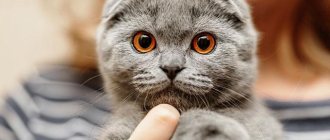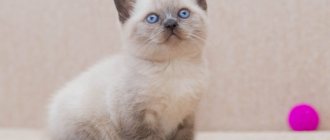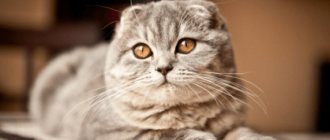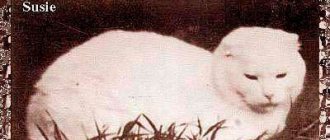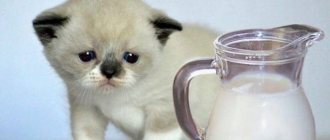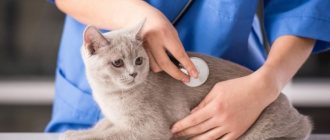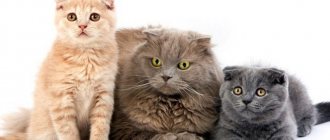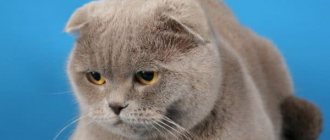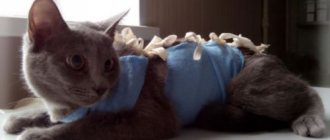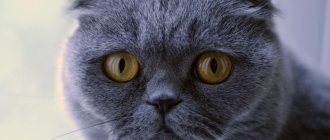Scottish Fold cats have fans all over the world: their small, downturned ears leave no one indifferent. But, unfortunately, it is precisely because of this feature that Scottish Folds are susceptible to osteochondrodysplasia. We will find out what this disease is, how it manifests itself, and we will also look at how to care for a sick cat, what to feed and how to treat it.
Description of the disease
Osteochondrodysplasia in cats (OCD or osteochondrodystrophy) is a genetic malformation of bones and cartilage that leads to slower growth and deformation.
Interesting! Translated from Greek, “osteo” means “bone,” and “dysplasia” means “developmental disorder.”
Osteochondrodysplasia most often affects Scottish Folds, since the disease is directly related to the gene for fold ears. Scots' downturned ears remain this way due to insufficient cartilage formation and disruption of its formation. The lop ear gene is responsible not only for ear deformation, but also for disruption of cartilage formation throughout the body.
Chondrodysplasia usually affects cats' limbs, thoracic, lumbar and caudal vertebrae. This disease can also manifest itself in the form of achondroplasia. With this disease, the cat’s paws cannot grow to normal size, so the pet develops dwarfism.
Osteochondrodysplasia is not life-threatening in most cases, but it can significantly reduce the quality and duration of life.
Prevention and hygiene of paws
Quite often you can see a cat washing itself. She licks her paws thoroughly. Cat saliva contains the enzyme lysozyme, which has a pronounced antiseptic property. It is this substance that ensures the hygiene of the paws and all places that the animal licks.
If an animal visits the street, it is a good idea to wash its paws with lukewarm water and wipe with a napkin. If the walk happened in the rain, then you should wash the dirt more thoroughly.
Some owners limit themselves to wiping their paws with special wet, scented wipes. This cannot be done. Such napkins are impregnated not only with “perfume” but also with other substances, and the animal, by licking its paws, can swallow the remains.
The basis of lump prevention is inspection and palpation. When playing or stroking an animal, you can always notice on or under the skin:
- seals;
- wounds;
- areas of skin without fur;
- cones;
- growths.
Any foreign body that is not familiar to the animal should alert you. While observing an animal, it is easy to spot a place of increased interest. It is necessary to immediately examine it to identify the cause.
A timely visit to a specialist will help identify the pathological process at the initial stages, establish a diagnosis and provide timely, qualified assistance.
Causes
Osteochondrodysplasia in cats is inherited. Its manifestation is not related to the gender of the animal.
OCD is considered a disease of Scottish Fold cats, because they are the owners of a mutant gene for fold ears. To avoid the appearance of offspring with osteochondrodysplasia, breeders always cross fold-eared cats with straight-eared cats. In this case, the risk of a dangerous gene appearing is minimal. However, in rare cases, even crossing a straight with a fold may result in a kitten with osteochondrodysplasia. That is why in some countries it is prohibited to breed Scottish Fold cats.
In Scottish Folds, the disease varies in severity. The most common disorders are the development of the bone skeleton, but in the most severe situations, deformation of the limbs can develop.
Forecasts
The lifespan of Scottish cats affected by osteochondrodysplasia is difficult to predict in advance. It largely depends on how willing the owners are to care for a disabled kitten.
For long-term prognosis, it is necessary to exclude other genetic diseases of Scottish cats, which can occur with irresponsible breeding as often as osteochondrodysplasia. These are polycystic kidney disease and hypertrophic cardiomyopathy, which can be detected using ultrasound.
With mild osteochondrodysplasia, cats can live for years, although they require constant supportive treatment and special housing conditions. For example, they may find it painful to go to the toilet, which leads to urination in the wrong places and chronic constipation.
If the sick kitten is homozygous for the lop-eared gene (both parents are Scottish Folds), the prognosis for life is extremely unfavorable. Bone deformation causes severe pain, which becomes increasingly difficult to relieve with age. The animal cannot move, and at some point the owners resort to euthanasia as a means of ending the suffering of their beloved pet.
Clinical symptoms
Unfortunately, owners notice signs of osteochondrodysplasia in their pet only when they become pronounced. Main clinical symptoms of the disease:
- lameness;
- head too big;
- crooked teeth;
- stiff gait;
- jaw protruding forward;
- excessively short and flattened nose;
- the appearance of growths on the paws;
- refusal to move and jump;
- the tail is too short and inactive;
- pain during movement;
- twisted and shortened limbs;
- walking on bent legs.
- The base of the tail is too thin.
Important! Osteochondrodysplasia of Scottish Fold cats most often appears at the age of 1.5–2 months. If the gait of a small Scottish Fold is stiff and the tail is motionless, then the kitten is not recommended for purchase.
How long do cats usually live?
Representatives of small cats in the wild live relatively short lives - 5-6 years. The lifespan of stray cats is approximately the same. Reasons for this:
- poor diet;
- irregular meals;
- invasive diseases;
- infections;
- lack of protection from predators;
- stress associated with the struggle for survival;
- harsh climatic and weather conditions.
The shortest lifespan—4 years—is for cats that, by chance, end up on the street. After a comfortable stay at home, they do not adapt well to the new environment. The fate of neutered cats is even sadder: being unable to compete for a place in the hierarchy, they immediately become outcasts from the pack and do not live more than three years. A little more time—approximately 3.5 years—is given to cats whose bodies are exhausted by constant pregnancies, childbirth, and nursing offspring.
Different fate and life expectancy for cats with loving owners
Care and attention, human patronage, and the opportunity to receive veterinary care allow them to live 15 years or more
The absolute champion in survival is the cat Lucy. At the time the record was entered into the Guinness Book (2011), according to the owners, she was 39 years old.
Return to content
Diagnostic methods
Diagnosis of osteochondrodysplasia in Scottish cats is carried out on the basis of a visual examination, as well as a study of the animal’s pedigree. In addition, to make a final diagnosis, the veterinarian will prescribe the following tests:
- General and biochemical blood test.
- General and biochemical urine analysis.
- X-ray examination of the limbs, spine and tail.
In the image of a cat with osteochondrodysplasia, you can see the deformation of the skeleton, and in the area of the limbs you can detect growths around the joints, while the gaps between them are very narrow. In severe cases of the disease, cartilage tissue is absent, and the vertebrae in the lumbar and caudal regions grow together.
How is the diagnosis made?
An examination is sufficient for a preliminary diagnosis. If you have a fold-eared kitten (or an adult cat) and you observe the following symptoms, you may suspect OCD:
– began to limp for no particular reason.
– the gait has changed. Protects one or more limbs, hunches over.
– there is a delay in growth, a violation of proportions (short legs, tail...).
– you observe deformation of the joints, most often the hind limbs are affected.
– the tail loses mobility, becomes like a “stick”, and when trying to bend the animal experiences pain.
To clarify, an x-ray is taken. The image evaluates the density of bone tissue, whether there are anatomical changes in the joints, the presence of bone exostosis (growth) and other changes.
The doctor may also recommend additional tests: general blood test, blood biochemistry, ultrasound…. In order to exclude other diseases or identify disorders that often develop in parallel with osteochondrodysplasia.
For example, kidney disease, mineral metabolism disorders, etc.
Treatment
Unfortunately, there is no treatment that would permanently rid a Scottish Fold cat of osteochondrodysplasia. Typically, sick animals are given supportive care to improve their quality of life.
At the initial stage of osteochondrodysplasia, Scottish Folds are usually treated with non-steroidal anti-inflammatory drugs (Ainil, Ketoline, Meloxivet) and chondroprotectors (usually chondroitin sulfate or glucosamine). Such medications stop the destruction of cartilage tissue and increase the amount of joint fluid.
Also, as support for sick pets, manual therapy in combination with massage is prescribed. These procedures improve blood circulation in the animal’s limbs and also help preserve the structure of cartilage tissue. True, they should only be performed by a highly qualified specialist.
In the most severe cases, it may even lead to surgical intervention. Typically, Scottish Fold cats with osteochondrodysplasia undergo the following operations, which give good results:
- Osteotomy. Helps eliminate deformation and improve the performance of the musculoskeletal system, remove growths on bone tissue. For osteotomy, one has to resort to artificially breaking the bones and then connecting them in the required form.
- Arthrodesis. The joint is fixed in an optimal position, after which it gradually ossifies. Mobility in the joint is lost forever, but the support ability of the limb is preserved. Arthrodesis is usually performed if the cat is unable to move or put weight on the affected limb due to severe pain.
Interesting! In Japan and Europe, radiation therapy is used to treat cats with osteochondrodysplasia. It helps reduce pain and slow down the destruction of joints. This method is very effective, but due to the too high cost and lack of necessary equipment in Russian veterinary clinics, it is not yet available.
Types of bumps on cats' paws and their causes
Cones can vary in:
- location (in soft tissues, bone, articular surface);
- color (white, pink, scarlet);
- density (soft, doughy, elastic).
There may be several reasons for this. The most common are:
- mechanical damage without violating the integrity of tissue (impacts, bruises, tears and ruptures of ligaments at the points of their attachment to the bone, damage to the bone base);
- mechanical damage with a violation of the integrity of the skin (puncture, cut, lacerations, which, due to the fur, remained unnoticed and developed into a chronic pathology);
- chemical damage (burns from chemicals, which also went unattended and led to deeper processes);
- thermal injuries (burns that developed into a lump after treatment);
- oncological factor (benign neoplasm, malignant of both soft and hard tissues);
- genetic factor (osteochondrodysplasia).
How to feed sick animals
To improve the quality of life of a Scottish Fold cat with OCD, owners should make their pet’s diet as balanced as possible. It should also contain additives that would help prevent fractures and reduce the rate of cartilage destruction. A Scottish fold cat with osteochondrodysplasia can be fed both natural food and ready-made food, but veterinarians still prefer the first option.
When choosing commercial food, owners need to pay attention to ensure that it is enriched with calcium, phosphorus, iodine, iron, and vitamins E and B. You can also purchase food for your pets that was specially designed for cats with sore joints. Manufacturers additionally introduce glucosamine and chondroitin into them, which, when used in combination, enhance each other’s effects.
When eating a natural diet, it is imperative to include raw meat, sinew and cartilage in the Scots diet.
Important! There is a misconception that Scottish Folds with OCD need to be given jellied meat. However, when boiled, the required amount of nutrients does not remain in the meat and cartilage. In addition, some of them are poorly absorbed by the cat’s body after prolonged cooking.
Owners of sick cats need to remember that such animals are prone to obesity due to a sedentary lifestyle. That is why you will have to constantly monitor the calorie content of the food your pet eats, as well as your pet’s weight, and weigh it regularly. If your cat is overweight, you need to work with your veterinarian to choose a diet for her, because obesity is dangerous not only for the musculoskeletal system, but also for the cardiovascular system.
How to extend the life of a pet
Let's find out what procedures will help your pet live longer:
Timely vaccination
Please note: even if your pet lives exclusively at home and never goes outside, harmful microorganisms can enter the house via outdoor clothing and other items. Balanced diet. If you prefer to give your cat commercial food, it should be premium or super premium.
Natural nutrition should include a large amount of protein: lean meat, fermented milk products, deboned sea fish once or twice a week. Vegetables are good for you. They can be given raw or cooked, depending on the cat’s preferences. Your pet should always have access to clean water. After consulting with a veterinarian, you can purchase mineral supplements for your pet to strengthen bones and cartilage tissue. Hygiene procedures are important. About 2 times a month you need to clean the animal’s ears using cotton pads and a special gel (sold in pet stores). A short-haired pet should be brushed once a week using a brush with short, stiff, dense teeth. The long-haired variety of Scottish cats is combed daily using a comb with sparse long teeth. It is not advisable to use slicker coats for Scots. Sterilization increases the life of a pet by 2–3 years (regardless of gender).
Do not forget that how long your pet will live largely depends on you.
Life expectancy of cats with OCD
Of course, all owners of Scottish fold cats with osteochondrodysplasia are concerned about the life expectancy of a pet with such a disease. Fortunately, the disease does not directly affect life expectancy. When the first symptoms of OCD appear, owners should take their cat to the doctor as soon as possible. After all, timely treatment can slow down the progression of the disease and improve the pet’s quality of life.
Some veterinarians suggest that owners euthanize a sick pet or amputate the affected limb. However, with good care, supportive care and patience on the part of the owner, the condition of the Scottish Fold cat can be significantly improved. You can also increase your pet's lifespan with a balanced diet.
Unfortunately, if the disease is too severe, it is still better for the animal to undergo euthanasia. It is suggested to do it if the disease is constantly progressing, the pet does not get up at all and does not go to the litter box, and he also has to take pills that no longer bring relief. In such a situation, it is better to stop the cat’s suffering, but the decision always remains with the owner.
Diagnosis by the appearance of the lump
The discovery of a lump can occur accidentally (while playing or stroking an animal) or due to symptoms of anxiety. If the lump doesn't bother your cat, it can grow slowly and then even disappear on its own without being noticed.
If the animal is worried, licks its paw or gnaws, tries to scratch it on objects, that is, pays increased attention to the place of pathology, then an examination should be carried out immediately.
If you have no experience in diagnosing diseases, it is very difficult even for a specialist to determine the course of the process and make a diagnosis by appearance (visually).
Diagnostic methods such as:
- palpation (palpation to determine the temperature of the local lesion and density, consistency);
- X-ray examination (to diagnose osteochondrodysplasia and other disorders in joints and bones);
- surgical opening of the local lesion.
Visually, pathology can be detected if the lump has its own character.
Soft
By palpation you can determine the density and degree of softness of the tissue. It should be taken into account that over time and the process, everything can change. For example, with a fresh hematoma, fluctuation is first felt (blood goes beyond the boundaries of the vessel and accumulates in the cavity or itself forms a cavity between muscle tissue or ligaments), skin tension and pain.
If microflora is introduced into the process, an abscess is formed. At the initial stage it is hard, then it becomes soft and the final stage will be self-opening with the expiration of purulent masses.
Soft swelling may be due to lymphatic exterovasation. In this case, the lower parts will be wider than the upper borders. If the process is left unattended, the tissues will become denser.
Solid
If, upon palpation, the lump is determined to be hard and the cat is a Scottish Fold, then osteochondrodysplasia (OCD) can be suspected. In this case, the bump may initially appear on one paw, or maybe on both at the same time. Exostases most often appear in the heel area. The skin on them loses its fur and may become ulcerated.
Hard formation also occurs with osteitis (inflammation of bone tissue). As a rule, this occurs in places not protected by soft tissues with damage to the periosteum.
Hard lumps occur as the end result of ruptures and sprains of ligaments, tendons, tendon sheaths (tendinitis and tendovaginitis) and muscles.
The aseptic reactive process leads to the proliferation of connective tissue and its compaction. It will feel hard to the touch. The process will be preceded by functional disorders (the cat will not be able to lean on its paw or will limp).
Black
Darkening of the skin may indicate an old process. If the lump has developed due to a hematoma, then the clotted blood will also give a dark blue or black color.
Red
The red color of the soft lump may indicate fresh oozing of blood. If the integrity of the blood vessels is broken through thin skin, the abrasion will have a pink tint, which will darken over time.
No wool
There may be no fur at the site of the bump if mechanical damage causes the pathology or if the cat constantly licks the area that bothers it.
If the process becomes purulent, then lysis of the hair follicles provokes hair loss and the area becomes bald.
Purulent
This process prior to disruption of integrity is partially described for soft cones. If the tissues have already been lysed and the pus comes out, then difficulties may arise in the sense that there may be “pockets” that will hold purulent masses.
The process cannot be ignored. The microflora of pus can be very aggressive.
Absorbed into the blood, it causes sepsis. During a purulent process, special attention should be paid to the general condition of the body and be sure to measure the temperature. If the readings are elevated, you should consult a doctor immediately.
The lump is bleeding
Moist and wet processes with leakage of lymph and blood can occur in both acute and chronic processes.
Disruption of the blood supply to a certain area of tissue causes the sweating of cellular elements outside the vessels.
The process can be complicated if the inflamed area is contaminated with pathogenic microflora. In this case, purulent processes are possible. Help should be provided immediately.
On the joint
If a lump has formed on a joint or near the articular surface, then inflammatory processes of the cartilaginous surfaces of the joints, tendons and tendon sheath, ligaments and bones are possible.
The lump will be dense. Impaired limb function may be observed, or the process may proceed without it.
Vaccination of Scottish Fold cats
Vaccination is one of the first preventive measures for animals. The risk of developing the disease with timely vaccinations decreases significantly. The doctor chooses a set of medications based on the living conditions.
The first vaccine (usually complex or rabies) is given after 1.5 months, but no later than 2.5 months. You will need to come back for a second vaccination in six months. Upon reaching 12 months, vaccination is carried out annually at regular intervals. Before a year, medications for rhinotracheitis, microsporia, panleukopenia, calicivirus and calicivirosis must be supplied.
The offspring of a vaccinated cat, subject to mating rules, provides an increased level of immunity. Depending on the date of the mother's last vaccination, the baby's first vaccination may be delayed by 12 weeks. If there is no information about the cat, it is better not to delay the procedure beyond 8 weeks.
The procedure requires preparation:
Veterinarians constantly remind that even a domestic cat without outdoor walking needs disease prevention. The virus can come randomly from food, a person’s clothing, a toy, or water.
No vaccine provides 100% protection against the disease, but it significantly reduces the risk of severe forms.
What affects life expectancy
The main factors that determine a cat's lifespan include:
- heredity;
- conditions of detention;
- quality of diet;
- characteristics inherent in a particular breed;
- availability of veterinary care;
- features of the permanent habitat.
In addition, sterilized pets live several years longer than their counterparts who have preserved their reproductive organs: surgical intervention eliminates the possibility of infection through contact with an infected partner, as well as the development of diseases of the genitourinary system in older cats.
The so-called free range, and in fact - unsupervised stay on the street, increases the risk of death of a domestic cat from the aggression of other animals, various injuries, accidents, and dangerous infectious diseases. The life expectancy of a free-roaming cat is much shorter than that of a indoor pet.
Return to content
Case 3
A one-and-a-half-year-old intact female Scottish Fold was admitted to the Veterinary University Hospital of the Japan Veterinary and Life Sciences University due to lameness on the right pelvic limb of one year's duration. The animal could not jump. The cat resisted palpation of the right pelvic limb and did not land on it when jumping. There was no history of any treatment.
X-rays of all four limbs, tail, abdominal organs and chest were performed. The presence of bone tissue growth in the area of the tarsal, metatarsal and calcaneal bones on both sides was determined. Osteophytes were detected in the area of the tarsal joints on both sides. Radiographs of the tail revealed shortening and deformation of the caudal vertebrae. No lesions were found in the thoracic extremities.
Based on symptoms and clinical manifestations, as well as radiographic findings, the cat was diagnosed with Scottish Fold osteochondrodysplasia. Radiation therapy was performed on both pelvic extremities according to the protocol described above. Clinical manifestations resolved after 1 month from the start of radiation therapy. No acute adverse effects were observed. When X-rays were performed regularly over 16 months, no progression of bone lesions was detected. At 48 months, new zones of deformation were noted in the area of the tarsal joints on both sides, but this did not affect the activity of the animal. Further follow-up was 72 months without additionally identified pathologies. No late complications were noted.
